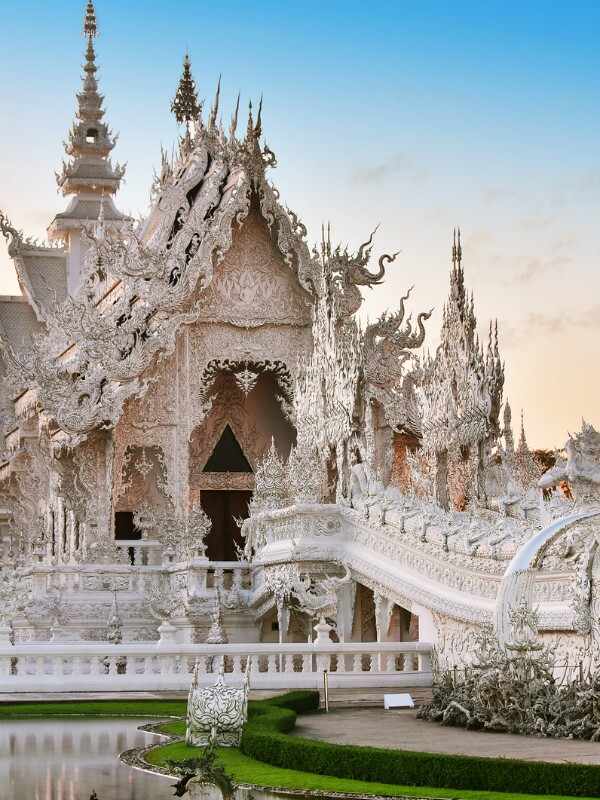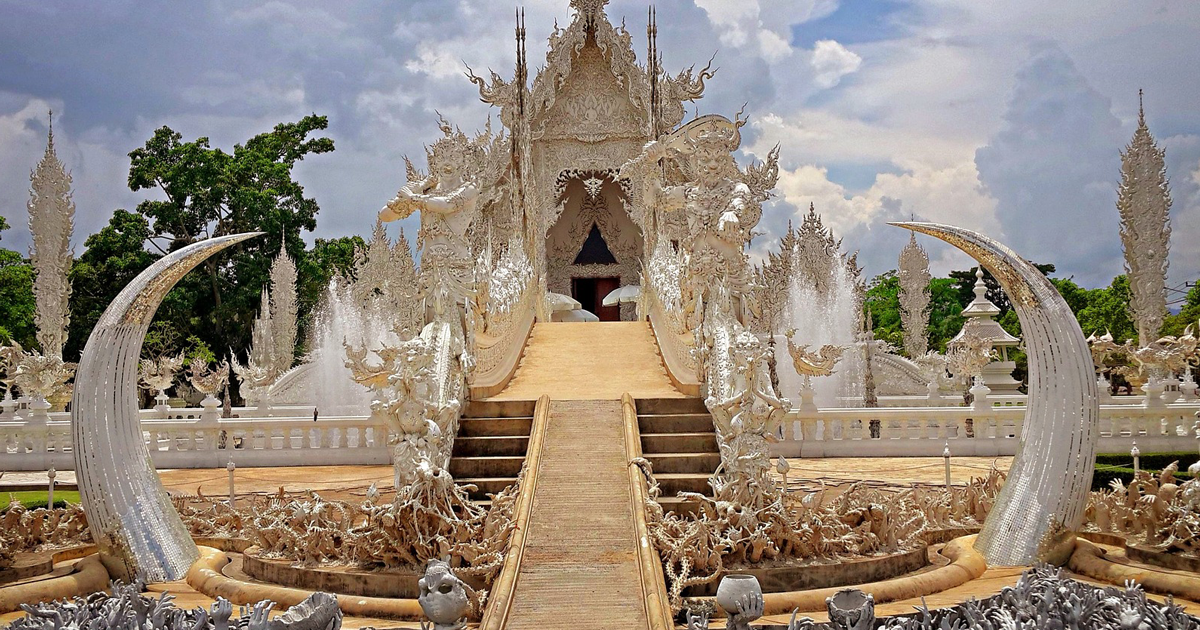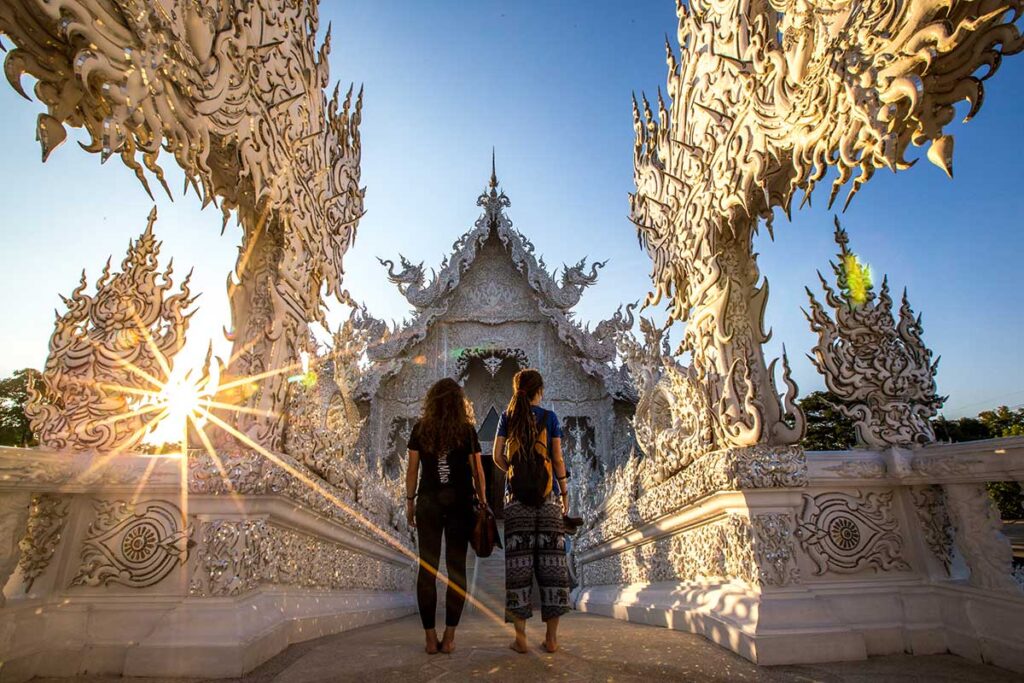So, have you ever wondered about the intricate artistry behind Thailand’s temples? The moment you step foot in these sacred grounds, you’ll be enveloped by a sense of awe and wonder. The temples, or “wats” as they are known locally, are not only places of worship but also stunning works of art. From the ornate exteriors adorned with intricate carvings to the vibrant interiors filled with intricate murals and golden statues, every detail is a testament to the craftsmanship and dedication of the artisans who built them.
Stepping inside a Thai temple is like being transported to a different world altogether. The attention to detail is simply remarkable. Take a moment to appreciate the delicately carved statues and figurines that line the walls, each one telling a story from Thai mythology and history. The eye-catching murals, painted in vivid colors, depict scenes from Buddhist scriptures and local folklore. It’s truly a feast for the eyes and a testament to the rich cultural heritage of Thailand.
But it’s not just the visual aspects that make the temples so fascinating. There’s also the meticulous construction techniques that have remained unchanged for centuries. The temples are built using traditional methods, with artisans using their hands and basic tools to create masterpieces that can last for generations. From the selection of the right materials to the precise placement of each stone, every step is done with utmost care and respect for the craft.
If you’re intrigued by the artistry and craftsmanship behind Thailand’s temples, then you’re in for a treat. In our upcoming article, we’ll delve deeper into the history and significance of these magnificent structures. We’ll explore the different architectural styles, the symbolism behind the designs, and the mystique surrounding these spiritual sanctuaries. So brace yourself for an enlightening journey through the intricate artistry of Thailand’s temples. Thailand is renowned for its breathtaking temples, known as “wats,” which embody the country’s rich cultural heritage and religious traditions. The intricate architecture and exquisite interior decorations of these temples make them a must-visit for travelers seeking to immerse themselves in Thailand’s unique charm. In this article, we will delve into the intricate artistry behind Thailand’s temples, explore the iconic temples of the country, and gain a deeper understanding of the spiritual significance and cultural importance of these sacred places.

Traditional Thai Temple Architecture
Thai temple architecture is characterized by its unique and intricate design elements that reflect a blend of influences from various Southeast Asian cultures. Traditional Thai temples typically consist of several buildings and structures enclosed within a gated compound. These structures include the main prayer hall, pagodas, libraries, and other auxiliary buildings.
Distinctive Features of Thai Temple Design
One of the most striking features of Thai temple design is the soaring roofs adorned with decorative elements such as golden finials, intricate sculptures, and colorful ceramics. These roofs, known as “prasat,” serve as symbolic representations of Mount Meru, the sacred mountain in Hindu and Buddhist cosmology.
Another characteristic feature of Thai temples is the “bot,” or ordination hall, which is considered the most important building in the temple complex. The bot is typically raised on a platform and features beautifully carved wooden pillars and walls. The roof of the bot is often adorned with ornate decorations and gilded stucco, showcasing the meticulous craftsmanship of Thai artisans.
Symbolism in Thai Temple Architecture
Thai temples are not only architectural marvels but also repositories of Buddhist symbolism and teachings. The design elements of a temple often convey various aspects of Buddhist cosmology and iconography. For example, the number and arrangement of spires on the pagodas represent different levels of existence in the Buddhist universe. The lotus flower motifs found in many temples symbolize purity and enlightenment, while the mythical creatures depicted in sculptures and murals serve as protective guardians against evil spirits.
The Exquisite Interior Decorations
Stepping inside a Thai temple is like entering a world of vibrant colors, intricate patterns, and mesmerizing details. The interior decorations of Thai temples are a testament to the artistic prowess of Thai craftsmen and the deep religious devotion of the Thai people.
Elaborate Murals and Paintings
Thai temple interiors are adorned with elaborate murals and paintings that depict scenes from Buddhist mythology, historical events, and moral teachings. These murals often cover the walls and ceilings, immersing visitors in a visual narrative that spans centuries of Thai history and Buddhist philosophy. The vibrant colors, intricate brushwork, and attention to detail in these murals make them a sight to behold.
Intricately Carved Wooden Panels
Woodcarving is a time-honored craft in Thailand, and it is prominently displayed in the interior decorations of temples. Intricately carved wooden panels featuring mythical creatures, deities, and floral motifs adorn the walls, doors, and windows of temples, adding a touch of elegance and grandeur to the sacred spaces.
Gilded Stucco and Ornamental Details
Gilded stucco is another hallmark of Thai temple design. This technique involves applying a layer of plaster mixed with gold leaf onto surfaces, creating a radiant, golden sheen. The gilded stucco is used to embellish various architectural elements such as pillars, door frames, and window frames. Ornamental details such as garlands, arches, and decorative motifs are meticulously incorporated into the design to create a visually stunning and harmonious atmosphere.

Iconic Temples in Thailand
Thailand is home to countless temples, each with its own unique charm and historical significance. Here are three iconic temples that should be on every traveler’s itinerary.
Wat Arun: The Temple of Dawn
Wat Arun, located on the Thonburi side of the Chao Phraya River in Bangkok, is one of the most recognizable landmarks in the city. Its towering spires, adorned with colorful porcelain tiles and seashells, make it a breathtaking sight to behold, especially during sunrise and sunset. As you ascend the steep steps of the central prang, you will be rewarded with panoramic views of the city skyline and the flowing waters of the Chao Phraya River.
Wat Phra Kaew: The Temple of the Emerald Buddha
Situated within the grounds of the Grand Palace in Bangkok, Wat Phra Kaew, or the Temple of the Emerald Buddha, is considered the most sacred temple in Thailand. Its main attraction is the small and revered Emerald Buddha statue, which dates back to the 14th century. The temple complex itself is a masterpiece of Thai craftsmanship, with its intricately carved decorations, gilded roofs, and stunning murals depicting scenes from the Ramakian, the Thai version of the Ramayana epic.
Wat Phra That Doi Suthep: The Sacred Mountain Temple
Perched on top of Doi Suthep, a mountain in Chiang Mai, Wat Phra That Doi Suthep offers not only stunning views of the city but also a spiritual retreat from the hustle and bustle below. The temple’s golden chedi, adorned with intricate filigree designs and surrounded by cascading waterfalls, is a symbol of Chiang Mai and a testament to the beauty of Thai temple architecture. Legend has it that the location of the temple was selected by an elephant carrying a relic of the Buddha, and the temple was built at the spot where the elephant stopped.
The Importance of Buddhism in Thai Culture
Buddhism holds a central place in Thai culture and plays a significant role in the lives of the Thai people. Thai Buddhism, also known as Theravada Buddhism, is deeply rooted in the country’s history, traditions, and daily life.
Buddhist Beliefs and Practices in Thailand
Buddhism teaches the path to end suffering and attain enlightenment. Thai Buddhists strive to follow the teachings of the Buddha, which emphasize compassion, mindfulness, and the cultivation of wholesome qualities. Meditation, along with acts of generosity and kindness, forms an integral part of Buddhist practice in Thailand.
The Role of Temples in Thai Society
Temples serve as the spiritual and cultural centers of Thai communities. They provide a place for worship, meditation, and learning, as well as for various community activities. Thai people often visit temples to make merit, offer prayers, and seek guidance from monks. Temples also play a crucial role in providing education, healthcare, and social services to the local communities.
Religious Festivals and Ceremonies
Thailand is known for its vibrant religious festivals and ceremonies, which are deeply rooted in Buddhist traditions. Festivals such as Songkran, the Thai New Year celebration, and Loi Krathong, the Festival of Lights, are celebrated with great enthusiasm throughout the country. These festivals offer a glimpse into the cultural and spiritual heritage of Thailand and provide an opportunity for locals and visitors alike to participate in joyous communal celebrations.

Preservation and Restoration Efforts
Preserving and restoring Thailand’s historical temples is a challenging task that requires extensive resources and expertise. However, efforts are being made to protect these architectural gems and ensure their longevity for future generations to admire and appreciate.
Conservation Projects for Thai Temples
Several conservation projects have been initiated by the Thai government, non-profit organizations, and local communities to restore and preserve Thailand’s temples. These projects involve architectural research, structural repairs, wall painting restoration, and the training of craftsmen in traditional techniques.
Challenges in Maintaining Historical Temples
Maintaining historical temples poses various challenges, including natural disasters, urban development, pollution, and the effects of climate change. These threats can cause damage to the delicate structures and artworks of the temples, necessitating ongoing maintenance and restoration efforts.
UNESCO World Heritage Sites in Thailand
Several of Thailand’s temples have been recognized as UNESCO World Heritage Sites, highlighting their cultural and historical significance on a global scale. These include the Historic City of Ayutthaya, the Sukhothai Historical Park, and the Temple of Preah Vihear. The designation of these sites encourages international recognition and support for their preservation.
The Spiritual Significance of Thai Temples
Beyond their architectural beauty and cultural significance, Thai temples hold deep spiritual meaning for the Thai people and serve as sanctuaries for religious practices and spiritual contemplation.
Thai Temple Rituals and Traditions
Thai temples are filled with rich and vibrant rituals that reflect the unique blend of Hindu and Buddhist traditions. Monks chant prayers, perform sacred ceremonies, and bless devotees with holy water during various occasions. Offerings of flowers, incense, and candles are made by worshippers as acts of devotion and gratitude.
Meditation and Mindfulness Practices
Thai temples provide tranquil settings for meditation and mindfulness practices. Meditation is a core aspect of Buddhist practice, and many temples offer meditation retreats and courses for both locals and foreign visitors. The serene atmosphere and peaceful surroundings of the temples create the ideal environment for introspection and self-reflection.
Pilgrimage Sites for Thai Buddhists
Many Thai Buddhists undertake pilgrimages to important temples and sacred sites as a way to deepen their faith and seek spiritual enlightenment. These pilgrimages often involve long journeys to remote locations, testing the pilgrims’ perseverance and dedication to their religious beliefs.

Exploring the Temples of Bangkok
Bangkok, the capital city of Thailand, is home to numerous temples that showcase the country’s rich cultural heritage. Here are three must-visit temples in Bangkok that offer a glimpse into the city’s vibrant spiritual and architectural traditions.
Wat Phra Kaew and the Grand Palace
Located within the grounds of the Grand Palace, Wat Phra Kaew is a major tourist attraction and a spiritual center for Thai Buddhists. The temple houses the revered Emerald Buddha and features stunning examples of Thai temple architecture, including intricate murals, golden spires, and gilded decorations. The Grand Palace, with its intricate palaces and pavilions, is an architectural masterpiece that reflects the grandeur and opulence of the Thai royal court.
Wat Arun and the Chao Phraya River
Wat Arun, also known as the Temple of Dawn, is situated on the banks of the Chao Phraya River. As one of Bangkok’s most iconic landmarks, Wat Arun is best admired from the river, especially during sunset when the temple’s spires are illuminated, creating a magical ambiance. Visitors can also climb the steep steps of the main prang to enjoy panoramic views of the river and the city skyline.
Wat Pho and the Reclining Buddha
Wat Pho, located just south of the Grand Palace, is known for its massive reclining Buddha statue, which measures 46 meters in length and is covered in gold leaf. The temple complex is home to numerous other exquisite statues, colorful pavilions, and tranquil courtyards. Wat Pho is also renowned as the birthplace of traditional Thai massage, and visitors can indulge in a rejuvenating massage at the temple’s massage school.
Hidden Gems: Temples Off the Beaten Path
While the iconic temples of Bangkok are certainly worth a visit, Thailand’s lesser-known temples offer a chance to escape the crowds and explore the country’s hidden treasures. Here are three hidden gems that showcase the diversity and beauty of Thai temple architecture.
Wat Rong Khun: The White Temple
Located in Chiang Rai, Wat Rong Khun, or the White Temple, is a contemporary masterpiece that is unlike any other temple in Thailand. Designed by the renowned artist Chalermchai Kositpipat, the temple features intricate white carvings and mirror-like mosaics that create a surreal and ethereal atmosphere. The interior of the temple is adorned with intricate murals that depict scenes from popular culture, including superheroes and movie characters, juxtaposed with traditional Buddhist iconography.
Wat Chedi Luang: The Ancient City Temple
Situated in the heart of Chiang Mai’s old city, Wat Chedi Luang is a testament to the city’s rich history and cultural heritage. The temple’s towering chedi, or pagoda, was once the tallest structure in ancient Chiang Mai. Though partially ruined, the chedi remains an impressive sight, with its massive size and intricate stone carvings. The temple complex also houses various other structures, including a prayer hall and monk’s quarters, which provide a glimpse into the daily life of monks in Chiang Mai.
Wat Phumin: The Temple of the Whispering Buddha
Tucked away in the small town of Nan, Wat Phumin is known for its unique architectural design and exquisite mural paintings. The temple is famous for its central Buddha statue, known as the “Whispering Buddha,” which is portrayed with its lips partially open as if imparting sacred teachings. The stunning murals adorning the walls depict scenes from local folklore and daily life, offering a glimpse into the history and culture of the Nan province.

Traditional Thai Temple Festivals
Thailand’s temple festivals are characterized by vibrant colors, lively processions, and joyous celebrations. These festivals provide a unique opportunity to witness the cultural traditions and religious rituals that are an integral part of Thai society.
Songkran: Thai New Year Celebration
Songkran, held annually from April 13 to 15, is one of Thailand’s most anticipated festivals. Celebrated as the Thai New Year, Songkran is a time for family reunions, temple visits, and water-related festivities. People engage in water fights, symbolizing the washing away of the past year’s misfortunes and the welcoming of the coming year with renewed vigor and positivity.
Loi Krathong: Festival of Lights
Loi Krathong, usually held in November, is a festival that celebrates the beauty and power of water. During this festival, thousands of intricately decorated krathongs, or floating baskets, are released onto rivers, lakes, and canals, carrying away bad luck and wishes for good fortune. The night sky is illuminated with lanterns, creating a magical atmosphere and symbolizing the letting go of negative thoughts and embracing positivity.
Visakha Bucha: Commemorating the Birth, Enlightenment, and Death of the Buddha
Visakha Bucha, which falls on the full moon day of the sixth lunar month, is a significant day for Buddhists worldwide. It commemorates the birth, enlightenment, and death of the Buddha. Devotees flock to temples to meditate, make merit, and participate in candle-lit processions. The serene ambience and sense of spiritual devotion make this day truly special for Thai Buddhists.
Conclusion
Thailand’s temples encapsulate the country’s rich history, cultural heritage, and spiritual traditions. From the intricate architecture and elaborate interior decorations to the spiritual significance and cultural importance, Thai temples offer a window into the soul of Thailand. Exploring these temples allows you to appreciate the artistry and craftsmanship of Thai artisans, while also gaining a deeper understanding of Thai culture and Buddhism. So, the next time you find yourself in Thailand, make sure to immerse yourself in the beauty and significance of Thailand’s temples.
